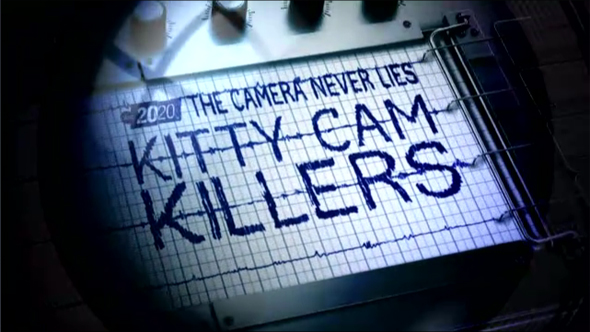
“There’s hostility to lying, and there should be.” —Bob Woodward
With just six minutes and 34 seconds to play, I don’t imagine readers got very far with their bingo cards during Friday night’s episode of 20/20 (“The Camera Never Lies: Kitty Cam Killers”). (My apologies for not including Killing Spree—I should have seen that one coming.) It was clear, though, from the footage of George Fenwick’s interview, that things could have played out very differently—the president of the American Bird Conservancy had his talking points down.
“Cats are responsible for the absolute extinction of at least 33 species of birds that we know about,” claimed Fenwick. Had he been asked to name, say, two of those birds,* I suspect we would have gotten a deer-in-the-headlights reaction reminiscent of Fenwick’s performance last year on The Daily Show. I don’t know if he would have gotten any further than the Stephens Island Wren.
Of course, as I’ve pointed out, there isn’t much further to go as far as those often-cited 33 extinctions are concerned. Each of the alleged extinctions took place on oceanic islands—situations largely irrelevant to the management of free-roaming cats in Athens, GA, or most anywhere else in the U.S. What’s more, only eight instances were attributed to cats exclusively; and of those, just two species are actually extinct.
The only other talking point Fenwick got in (other than his appeal for enclosures) was ABC’s new “estimate”—1.2 billion birds killed each year by cats—unveiled just for the occasion, it seems. A month ago, his “extrapolations” resulted in a figure of “at least 500 million birds.” What’s changed? Just the promise of a larger audience, I suspect.
Besides, when it comes to the witch-hunt against free-roaming cats, Fenwick and ABC have never been burdened with a need for consistency or supporting evidence.
Not to be outdone, the University of Georgia’s Sonia Hernandez—Kerrie Anne Loyd’s PhD advisor—had her own indefensible talking points. “There are an estimated 150 million cats that roam outside,” she told Roberts. Again, we need to put quotes around estimate.
Hernandez is, of course, citing the work of her one-time colleague, Nico Dauphiné (whom she defended in an reply to an e-mail I sent her following Dauphiné’s conviction on attempted animal cruelty charges last year: “In all my interactions with her, I have known Nico to be a very responsible scientist and a very caring individual, both to people and to all animals.”) Among the many flaws in “Impacts of Free-ranging Domestic Cats” was the authors’ estimate of “117 to 157 million exotic predators,” which was based on David Jessup’s inflated (and, not surprisingly, unattributed) “estimate” of “60 to 100 million feral and abandoned cats.” [1] Accounting for pet cats, the authors ignore or overlook the multiple large-scale surveys demonstrating that about two-thirds of cats are indoor-only, [2–4] thus further inflating their “estimate.”
It appears, based on what I’ve seen so far, that Loyd’s research ignores or overlooks the same surveys. (Loyd was, she tells me, unable to travel to New York or Georgia for 20/20’s shooting schedule.)
In the end, it’s difficult to argue with 20/20’s basic premise: the camera never lies.** If only the people overseeing their use, analyzing their footage, and commenting on their revelations were so honest.
• • •
Readers interested in contacting 20/20 about the segment will find an online form here. (Unfortunately, there’s a 500-character limit.)
*The 20/20 team’s apparent lack of curiosity—disappointing, though not entirely unexpected—was a gift to both Fenwick and Hernandez.
**Assuming one isn’t considering lies of omission, of course.
Literature Cited
1. Jessup, D.A., “The welfare of feral cats and wildlife.” Journal of the American Veterinary Medical Association. 2004. 225(9): p. 1377–1383. http://www.ncbi.nlm.nih.gov/pubmed/15552312
http://www.avma.org/avmacollections/feral_cats/javma_225_9_1377.pdf
2. Clancy, E.A., Moore, A.S., and Bertone, E.R., “Evaluation of cat and owner characteristics and their relationships to outdoor access of owned cats.” Journal of the American Veterinary Medical Association. 2003. 222(11): p. 1541-1545. http://avmajournals.avma.org/doi/abs/10.2460/javma.2003.222.1541
3. Lord, L.K., “Attitudes toward and perceptions of free-roaming cats among individuals living in Ohio.” Journal of the American Veterinary Medical Association. 2008. 232(8): p. 1159–1167. http://www.avma.org/avmacollections/feral_cats/javma_232_8_1159.pdf
4. APPA, 2009–2010 APPA National Pet Owners Survey. 2009, American Pet Products Association: Greenwich, CT. http://www.americanpetproducts.org/pubs_survey.asp
